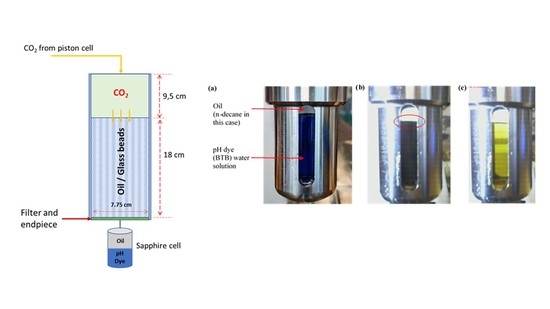CO2 Convective Dissolution in Oil-Saturated Unconsolidated Porous Media at Reservoir Conditions
Abstract
:1. Introduction
2. Experimental Method
2.1. Materials
2.2. Experimental Setup
2.3. Experimental Procedure
- 1.
- The steel column was wet packed with glass beads manually (filled the column with oil type first and dry glass beads into oil), with the specified size to a height of 18 cm, and filled the rest of the volume to the top with the oil type that was being used.
- 2.
- After mounting all the devices, V1, V3, and V5 were opened and the oil was pumped through the packed column using the Quizix pump and pressurized to 100 bar until produced through the back-pressure regulator to make sure 100% oil saturation was obtained.
- 3.
- The pump was stopped and waterside from the CO2 piston cell (V2) was opened while V1, V3, and V5 were kept opened.
- 4.
- Then, the system was heated to 50°. With the temperature increase, CO2 inside the CO2 piston cell expanded. Hence, water from the CO2 piston cell was transferred to the oil piston cell where pressurized oil was transferred through the packed column via the back-pressure regulator. This way, it was made sure that packed column pressure and the CO2 piston cell pressure stayed the same.
- 5.
- Afterward, V1 and V3 were closed. CO2 piston cell was introduced to the packed column by opening V4. A specified amount of CO2 (450 mL) was injected at a high rate (50 mL/min) and out through the back-pressure regulator (V5 was still opened) to create a 9.5 cm height of free phase of CO2 on top of the oil-saturated porous media (as shown in Figure 3). With previous experience, it was calculated that a height of 9.5 cm was required to compensate for the oil swelling so that swelled oil due to CO2 mixing was not transported into the CO2 piston cell.
- 6.
- The connection between the packed column and back-pressure regulator (V5) was closed after the injection and the pump was stopped and pressure decay data were logged using the computer application.
- 7.
- A small web camera with an interval timer shooting was used to monitor the breakthrough of CO2 into the sapphire cell. CO2 was transported through the oil-saturated porous media and a breakthrough was observed through the color change of water solution from blue to yellow (see Figure 6b).
2.4. Set of Experiments
3. Results and Discussions
4. Conclusions
Author Contributions
Funding
Institutional Review Board Statement
Informed Consent Statement
Data Availability Statement
Acknowledgments
Conflicts of Interest
Nomenclature
| Density of CO2 () | |
| Density of oil () | |
| Maximum density of oil + CO2 mixture () | |
| Density increase of the fluid due to CO2 dissolution () () | |
| Dimensionless time (-) | |
| Porosity (-) | |
| Dynamic viscosity of the fluid () | |
| Molecular diffusion co-efficient of CO2 in the fluid () | |
| Acceleration of gravity () | |
| Test height of porous media () | |
| Permeability of the porous media () | |
| Rayleigh number (-) | |
| Critical Rayleigh number (-) |
Abbreviations
| Super critical CO2 | |
| 2-dim | 2-dimensional |
| 3-dim | 3-dimensional |
References
- Hannis, S.; Lu, J.; Chadwick, A.; Hovorka, S.; Kirk, K.; Romanak, K.; Pearce, J. CO2 Storage in Depleted or Depleting Oil and Gas Fields: What can We Learn from Existing Projects? Energy Procedia 2017, 114, 5680–5690. [Google Scholar] [CrossRef]
- Godec, M.; Kuuskraa, V.; Van Leeuwen, T.; Stephen Melzer, L.; Wildgust, N. CO2 Storage in Depleted Oil Fields: The Worldwide Potential for Carbon Dioxide Enhanced Oil Recovery. Energy Procedia 2011, 4, 2162–2169. [Google Scholar] [CrossRef] [Green Version]
- Mansour, E.M.; Al-Sabagh, A.M.; Desouky, S.M.; Zawawy, F.M.; Ramzi, M. A Laboratory Investigation of Carbon Dioxide-Enhanced Oil Recovery by Focusing on CO2-Oil Physical Properties. Egypt. J. Pet. 2019, 28, 21–26. [Google Scholar] [CrossRef]
- Holm, L.W. CO2 Flooding: Its Time Has Come. J. Pet. Technol. 1982, 34, 2739–2745. [Google Scholar] [CrossRef]
- Blunt, M.; Fayers, F.J.; Orr, F.M. Carbon Dioxide in Enhanced Oil Recovery. Energy Convers. Manag. 1993, 34, 1197–1204. [Google Scholar] [CrossRef]
- Brock, W.R.; Bryan, L.A. Summary Results of CO2 EOR Field Tests, 1972–1987. In Proceedings of the Low Permeability Reservoirs Symposium, Denver, CO, USA, 6–8 March 1989; p. 10. [Google Scholar] [CrossRef]
- Ajayi, T.; Gomes, J.S.; Bera, A. A Review of CO2 Storage in Geological Formations Emphasizing Modeling, Monitoring and Capacity Estimation Approaches. Pet. Sci. 2019, 16, 1028–1063. [Google Scholar] [CrossRef] [Green Version]
- Han, W.S.; McPherson, B.; Lichtner, P.; Wang, F. Evaluation of Trapping Mechanisms in Geologic CO2 Sequestration: Case Study of Sacroc Northern Platform, a 35-Year CO2 Injection Site. Am. J. Sci. 2010, 310, 282–324. [Google Scholar] [CrossRef]
- Emami-Meybodi, H.; Hassanzadeh, H.; Green, C.P.; Ennis-King, J. Convective Dissolution of CO2 in Saline Aquifers: Progress in Modeling and Experiments. Int. J. Greenh. Gas Control 2015, 40, 238–266. [Google Scholar] [CrossRef]
- Sun, Y.; Li, Q.; Yang, D.; Liu, X. Laboratory core flooding experimental systems for CO2 geosequestration: An updated review over the past decade. J. Rock Mech. Geotech. Eng. 2016, 8, 113–126. [Google Scholar] [CrossRef] [Green Version]
- Gasda, S.; Elenius, M.T. CO2 Convection in Oil Driven by Non-Monotonic Mixture Density. In Proceedings of the 16th European Conference on the Mathematics of Oil Recovery, Barcelona, Spain, 3–6 September 2018; pp. 1–12. [Google Scholar] [CrossRef]
- Amarasinghe, W.; Fjelde, I.; Rydland, J.-Å.; Guo, Y. Effects of Permeability on CO2 Dissolution and Convection at Reservoir Temperature and Pressure Conditions: A Visualization Study. Int. J. Greenh. Gas Control 2020, 99, 103082. [Google Scholar] [CrossRef]
- Mahmoodpour, S.; Rostami, B.; Soltanian, M.R.; Amooie, M.A. Effect of Brine Composition on the Onset of Convection During CO2 Dissolution in Brine. Comput. Geosci. 2019, 124, 1–13. [Google Scholar] [CrossRef]
- Thomas, C.; Dehaeck, S.; De Wit, A. Convective Dissolution of CO2 in Water and Salt Solutions. Int. J. Greenh. Gas Control 2018, 72, 105–116. [Google Scholar] [CrossRef]
- Faisal, T.F.; Chevalier, S.; Bernabe, Y.; Juanes, R.; Sassi, M. Quantitative and Qualitative Study of Density Driven CO2 Mass Transfer in a Vertical Hele-Shaw Cell. Int. J. Heat Mass Transf. 2015, 81, 901–914. [Google Scholar] [CrossRef]
- Khosrokhavar, R.; Elsinga, G.; Farajzadeh, R.; Bruining, H. Visualization and Investigation of Natural Convection Flow of CO2 in Aqueous and Oleic Systems. J. Pet. Sci. Eng. 2014, 122, 230–239. [Google Scholar] [CrossRef]
- Vosper, H.; Kirk, K.; Rochelle, C.; Noy, D.; Chadwick, A. Does Numerical Modelling of the Onset of Dissolution-convection Reliably Reproduce this Key Stabilization Process in CO2 Storage? Energy Procedia 2014, 63, 5341–5348. [Google Scholar] [CrossRef] [Green Version]
- Taheri, A.; Torsæter, O.; Lindeberg, E.; Hadia, N.J.; Wessel-Berg, D. Qualitative and Quantitative Experimental Study of Convective Mixing Process During Storage of CO2 in Heterogeneous Saline Aquifers. Int. J. Greenh. Gas Control 2018, 71, 212–226. [Google Scholar] [CrossRef]
- Lv, P.; Liu, Y.; Chen, J.; Jiang, L.; Wu, B.; Liu, S.; Song, Y. Pore-scale Investigation of Effects of Heterogeneity on CO2 Geological Storage Using Stratified Sand Packs. Greenh. Gases: Sci. Technol. 2017, 7, 972–987. [Google Scholar] [CrossRef]
- Lv, P.; Liu, Y.; Jiang, L.; Song, Y.; Wu, B.; Zhao, J.; Zhang, Y. Experimental Determination of Wettability and Heterogeneity Effect on CO2 Distribution in Porous Media. Greenh. Gases Sci. Technol. 2016, 6, 401–415. [Google Scholar] [CrossRef]
- Zhao, Y.; Song, Y.; Liu, Y.; Liang, H.; Dou, B. Visualization and Measurement of CO2 Flooding in Porous Media Using MRI. Ind. Eng. Chem. Res. 2011, 50, 4707–4715. [Google Scholar] [CrossRef]
- Fang, F.; Babadagli, T. 3-D Visualization of Diffusive and Convective Solvent Transport Processes in Oil-saturated Porous Media Using Laser Technology. J. Vis. 2016, 19, 615–629. [Google Scholar] [CrossRef]
- Wang, S.; Liu, Y.; Zhao, Y.; Zhang, Y.; Jiang, L.; Yu, B.; Yin, Y.; Song, Y. Enhanced Mass Transfer by Density-Driven Convection During CO2 Geological Storage. Ind. Eng. Chem. Res. 2020. [Google Scholar] [CrossRef]
- Amarasinghe, W.; Fjelde, I.; Giske, N.H.; Guo, Y. CO2 Convective Dissolution in Water Saturated Unconsolidated Porous Media at Reservoir Conditions. In Proceedings of the 15th International Conference on Greenhouse Gas Control Technologies, GHGT-15, Abu Dhabi, UAE, 15–18 March 2021. [Google Scholar]
- Amarasinghe, W.S.; Fjelde, I.; Guo, Y. CO2 Dissolution and Convection in Oil at Realistic Reservoir Conditions: A Visualization Study. In Proceedings of the SPE Europec 2020 featured at 82nd EAGE Conference and Exhibition, Amsterdam, The Netherlands, 7 December 2020. [Google Scholar]
- Farajzadeh, R.; Delil, H.A.; Zitha, P.L.J.; Bruining, J. Enhanced Mass Transfer of CO2 Into Water and Oil by Natural Convection. In Proceedings of the EUROPEC/EAGE Conference and Exhibition, London, UK, 11–14 June 2007; p. 9. [Google Scholar] [CrossRef]
- Seyyedsar, S.M.; Sohrabi, M. Visualization Observation of Formation of a New Oil Phase During Immiscible Dense CO2 Injection in Porous Media. J. Mol. Liq. 2017, 241, 199–210. [Google Scholar] [CrossRef]
- Wei, B.; Gao, H.; Pu, W.; Zhao, F.; Li, Y.; Jin, F.; Sun, L.; Li, K. Interactions and Phase Behaviors Between Oleic Phase and CO2 From Swelling to Miscibility in CO2-Based Enhanced Oil Recovery (EOR) Process: A Comprehensive Visualization Study. J. Mol. Liq. 2017, 232, 277–284. [Google Scholar] [CrossRef]
- Gasda, S.E.; Elenius, M.T.; Kaufmann, R. Field-Scale Implications of Density-Driven Convection in CO2-Eor Reservoirs. In Proceedings of the Fifth CO2 Geological Storage Workshop, Utrecht, The Netherlands, 21–23 November 2018; pp. 1–5. [Google Scholar] [CrossRef]
- Both, J.; Gasda, S.; Aavatsmark, I.; Kaufmann, R. Gravity-driven Convective Mixing of CO2 in Oil. In Proceedings of the Third Sustainable Earth Sciences Conference and Exhibition, Celle, Germany, 13–14 October 2015; pp. 1–5. [Google Scholar] [CrossRef]
- Ahmed, T.; Nasrabadi, H.; Firoozabadi, A. Complex Flow and Composition Path in CO2 Injection Schemes from Density Effects. Energy Fuels 2012, 26, 4590–4598. [Google Scholar] [CrossRef]
- Rongy, L.; Haugen, K.B.; Firoozabadi, A. Mixing from Fickian Diffusion and Natural Convection in Binary Non-Equilibrium Fluid Phases. AIChE J. 2012, 58, 1336–1345. [Google Scholar] [CrossRef]
- Song, Y.; Jian, W.; Zhang, Y.; Shen, Y.; Zhan, Y.; Zhao, J.; Liu, Y.; Wang, D. Densities and Volumetric Characteristics of Binary System of CO2 + Decane from (303.15 to 353.15) K and Pressures up to 19 MPa. J. Chem. Eng. Data 2012, 57, 3399–3407. [Google Scholar] [CrossRef]
- Cadogan, S.P.; Mistry, B.; Wong, Y.; Maitland, G.C.; Trusler, J.P.M. Diffusion Coefficients of Carbon Dioxide in Eight Hydrocarbon Liquids at Temperatures between (298.15 and 423.15) K at Pressures up to 69 MPa. J. Chem. Eng. Data 2016, 61, 3922–3932. [Google Scholar] [CrossRef]
- Lee, A.L.; Ellington, R.T. Viscosity of n-Decane in the Liquid Phase. J. Chem. Eng. Data 1965, 10, 346–348. [Google Scholar] [CrossRef]
- Lindeberg, E.; Wessel-Berg, D. Vertical Convection in an Aquifer Column Under a Gas Cap of CO. Energy Convers. Manag. 1997, 38, S229–S234. [Google Scholar] [CrossRef]
- Wang, L.; Hyodo, A.; Sakai, S.; Suekane, T. Three-Dimensional Visualization of Natural Convection in Porous Media. Energy Procedia 2016, 86, 460–468. [Google Scholar] [CrossRef] [Green Version]
- Farajzadeh, R.; Salimi, H.; Zitha, P.L.J.; Bruining, H. Numerical Simulation of Density-Driven Natural Convection in Porous Media with Application for CO2 Injection Projects. Int. J. Heat Mass Transf. 2007, 50, 5054–5064. [Google Scholar] [CrossRef]
- Hebach, A.; Oberhof, A.; Dahmen, N. Density of Water + Carbon Dioxide at Elevated Pressures: Measurements and Correlation. J. Chem. Eng. Data 2004, 49, 950–953. [Google Scholar] [CrossRef]
- Efika, E.C.; Hoballah, R.; Li, X.; May, E.F.; Nania, M.; Sanchez-Vicente, Y.; Martin Trusler, J.P. Saturated Phase Densities of (CO2+H2O) at Temperatures from (293 To 450) K and Pressures up to 64 MPa. J. Chem. Thermodyn. 2016, 93, 347–359. [Google Scholar] [CrossRef] [Green Version]
- Wang, L.; Nakanishi, Y.; Hyodo, A.; Suekane, T. Three-dimensional Finger Structure of Natural Convection in Homogeneous and Heterogeneous Porous Medium. Energy Procedia 2017, 114, 5048–5057. [Google Scholar] [CrossRef]
- Rasmussen, A.F.; Sandve, T.H.; Bao, K.; Lauser, A.; Hove, J.; Skaflestad, B.; Klöfkorn, R.; Blatt, M.; Rustad, A.B.; Sævareid, O.; et al. The Open Porous Media flow reservoir simulator. Comput. Math. Appl. 2020. [Google Scholar] [CrossRef]
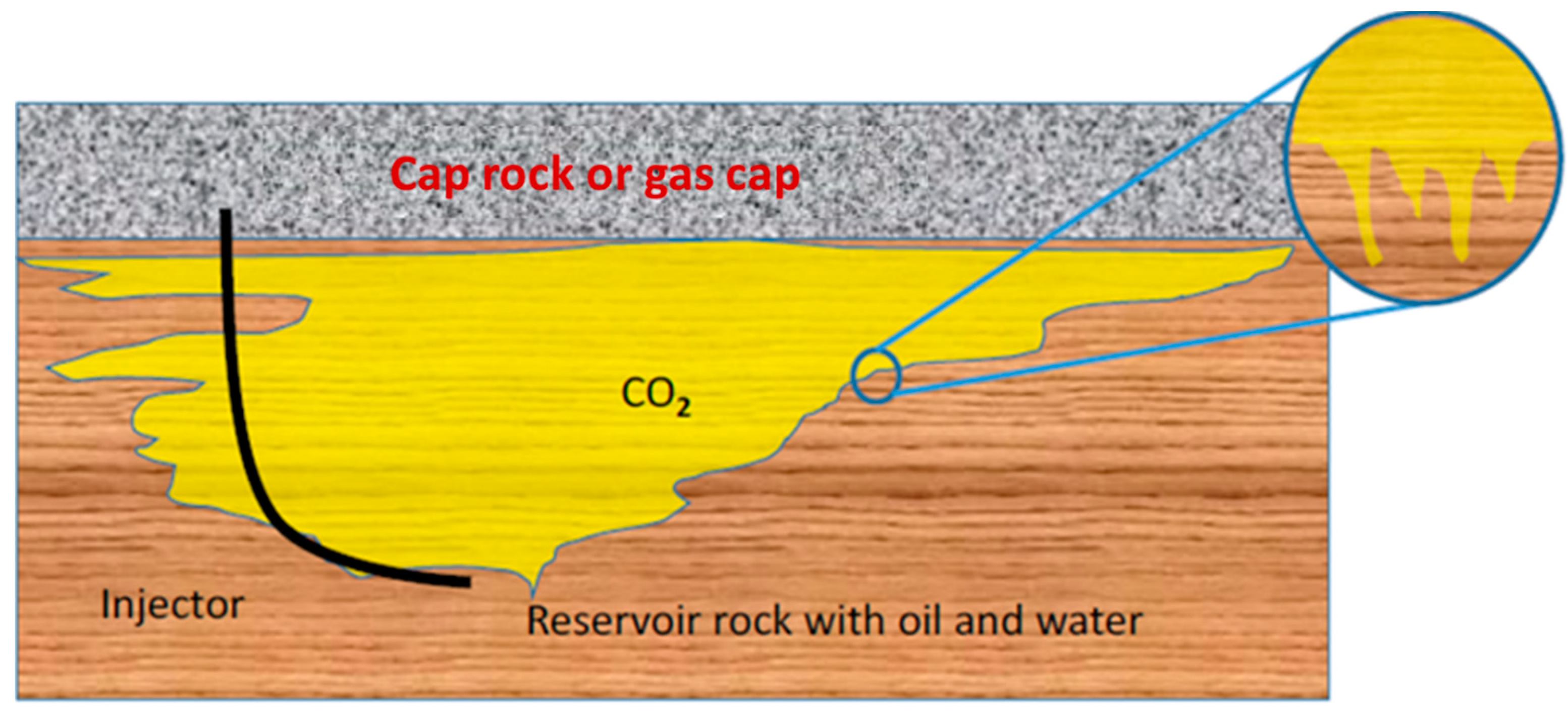
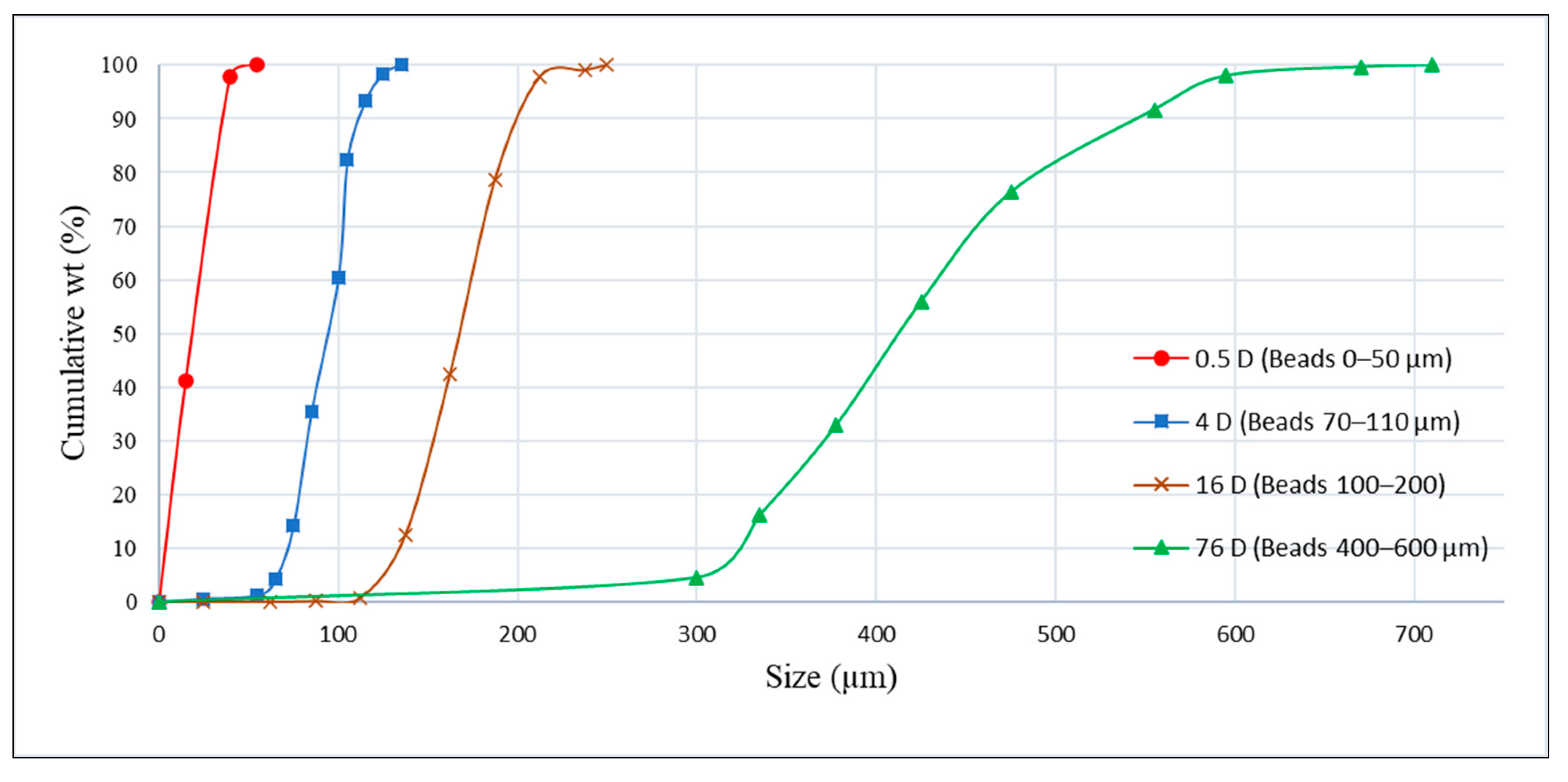
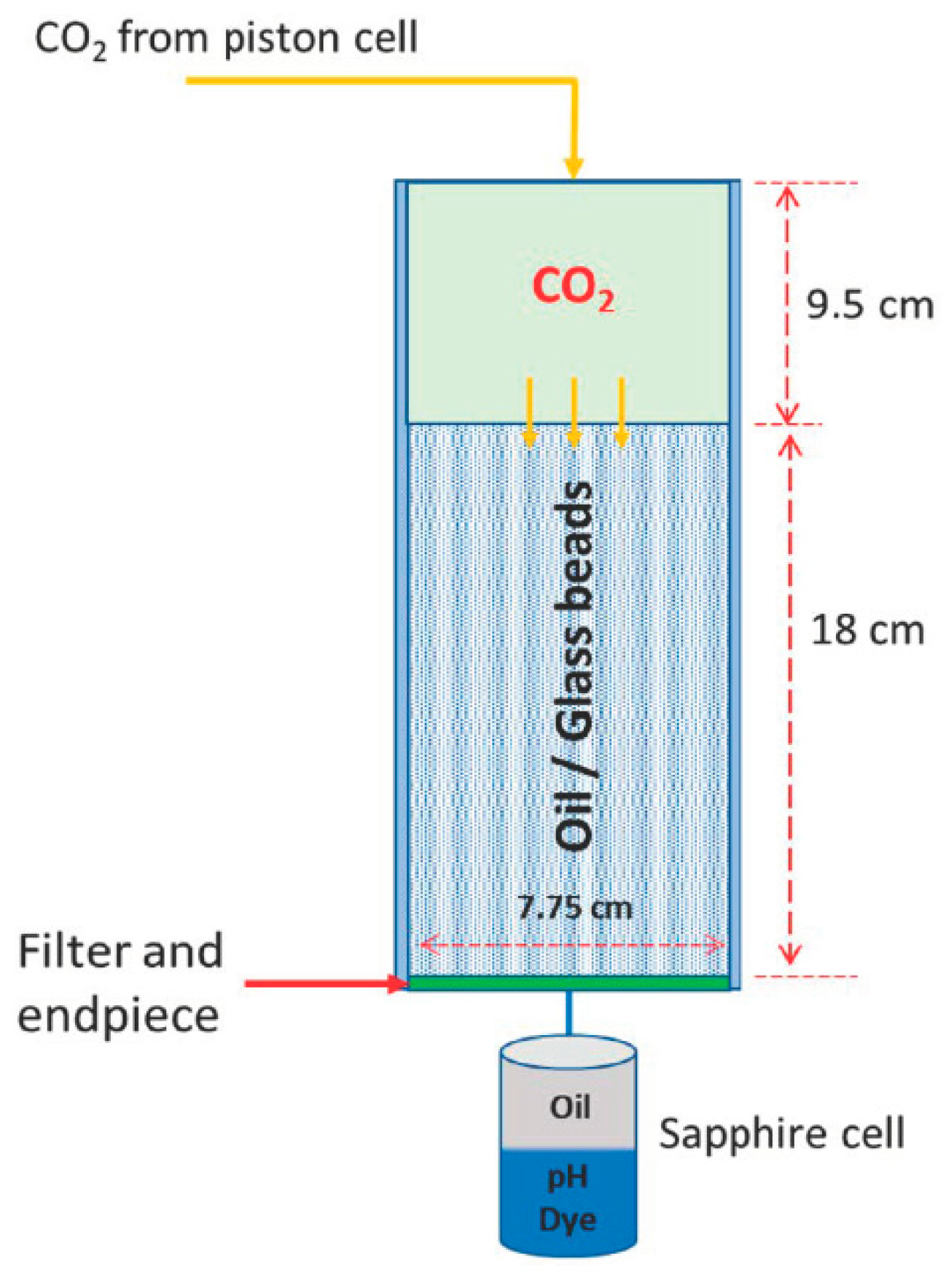

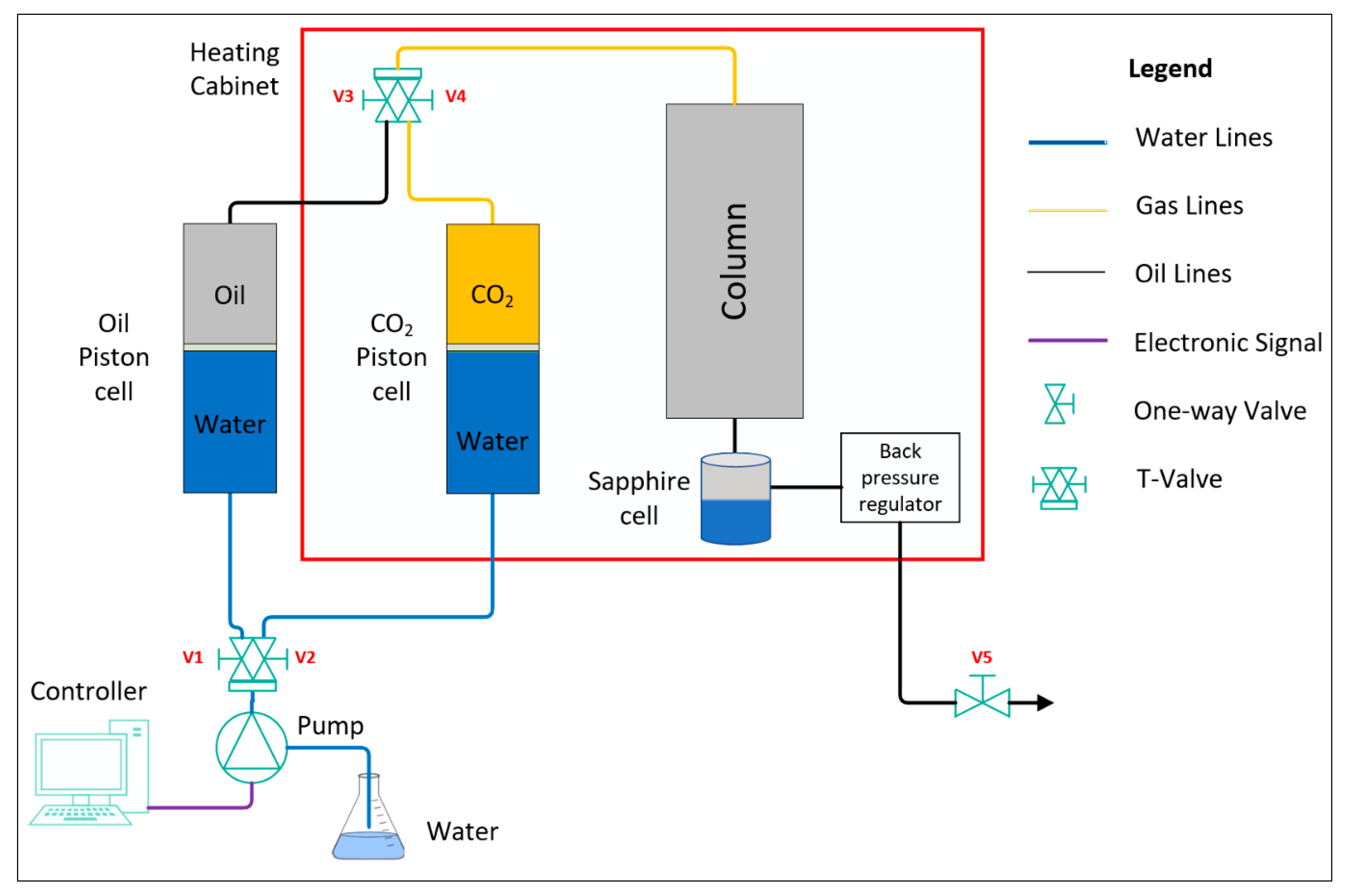
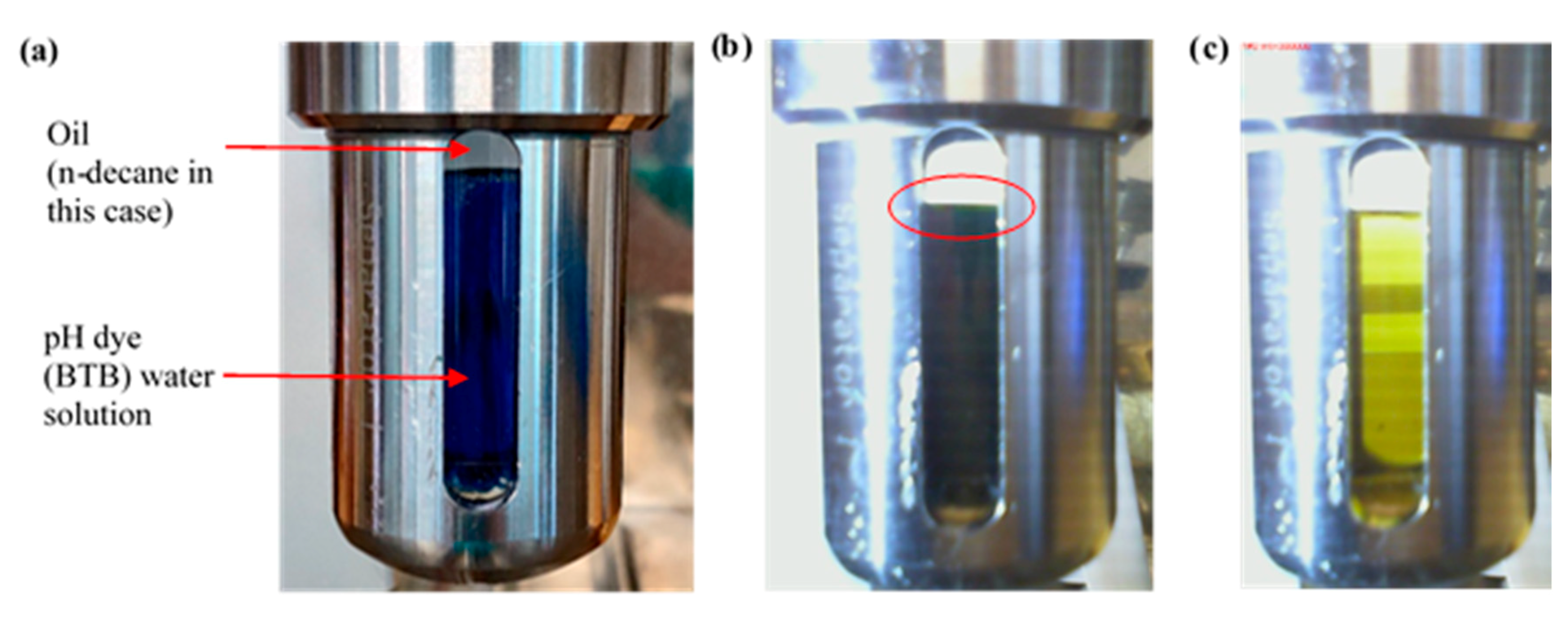

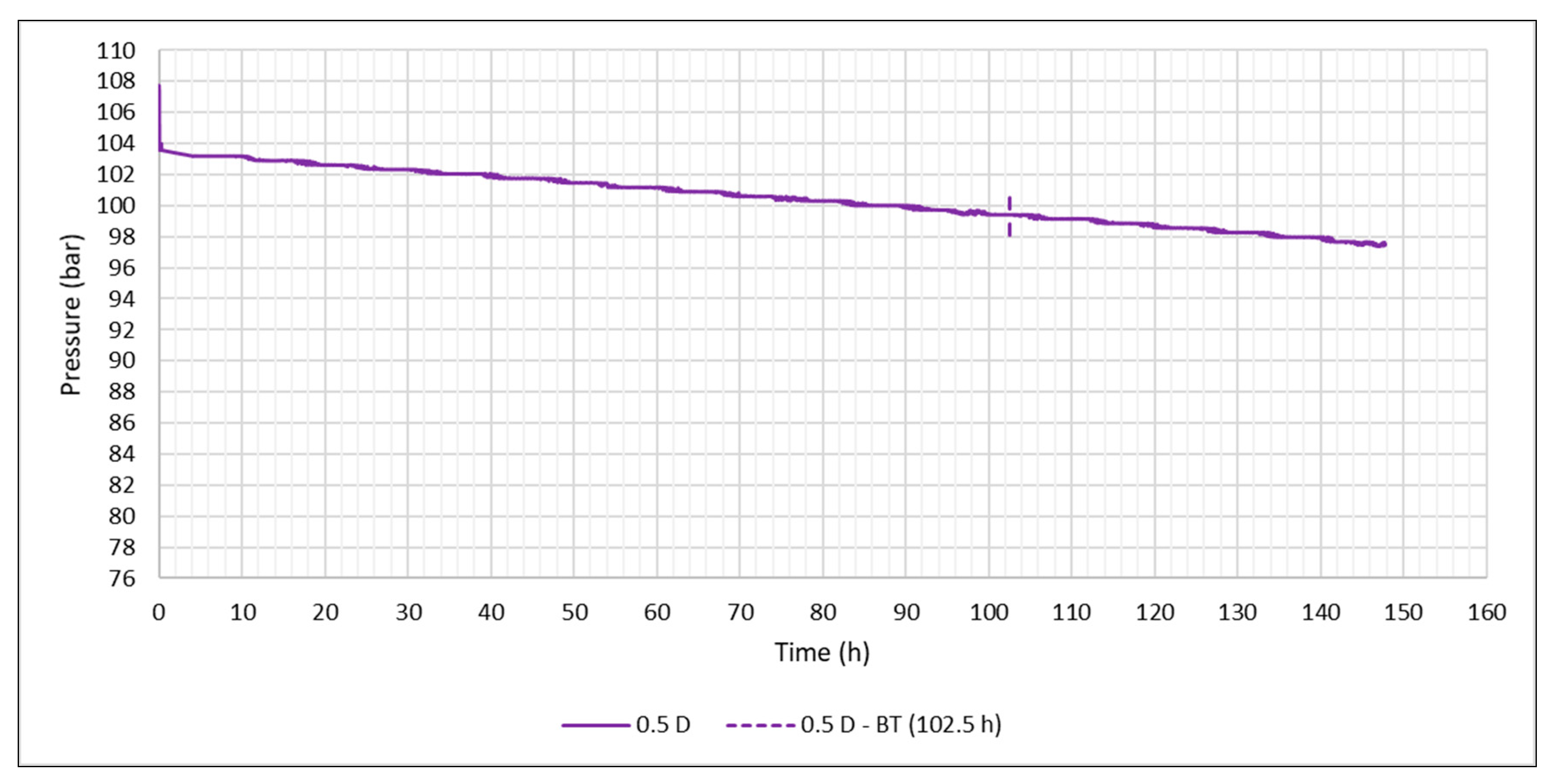
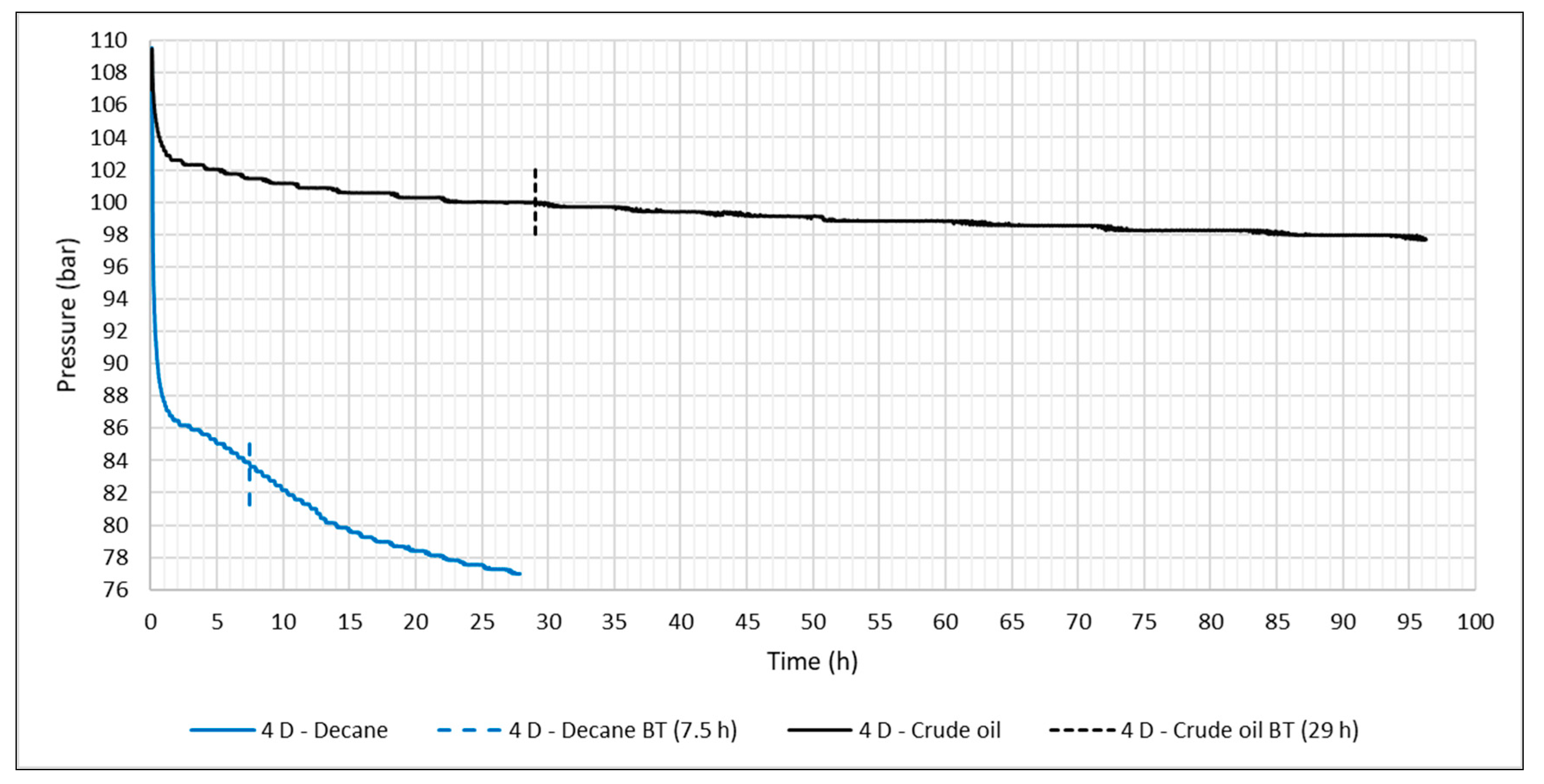
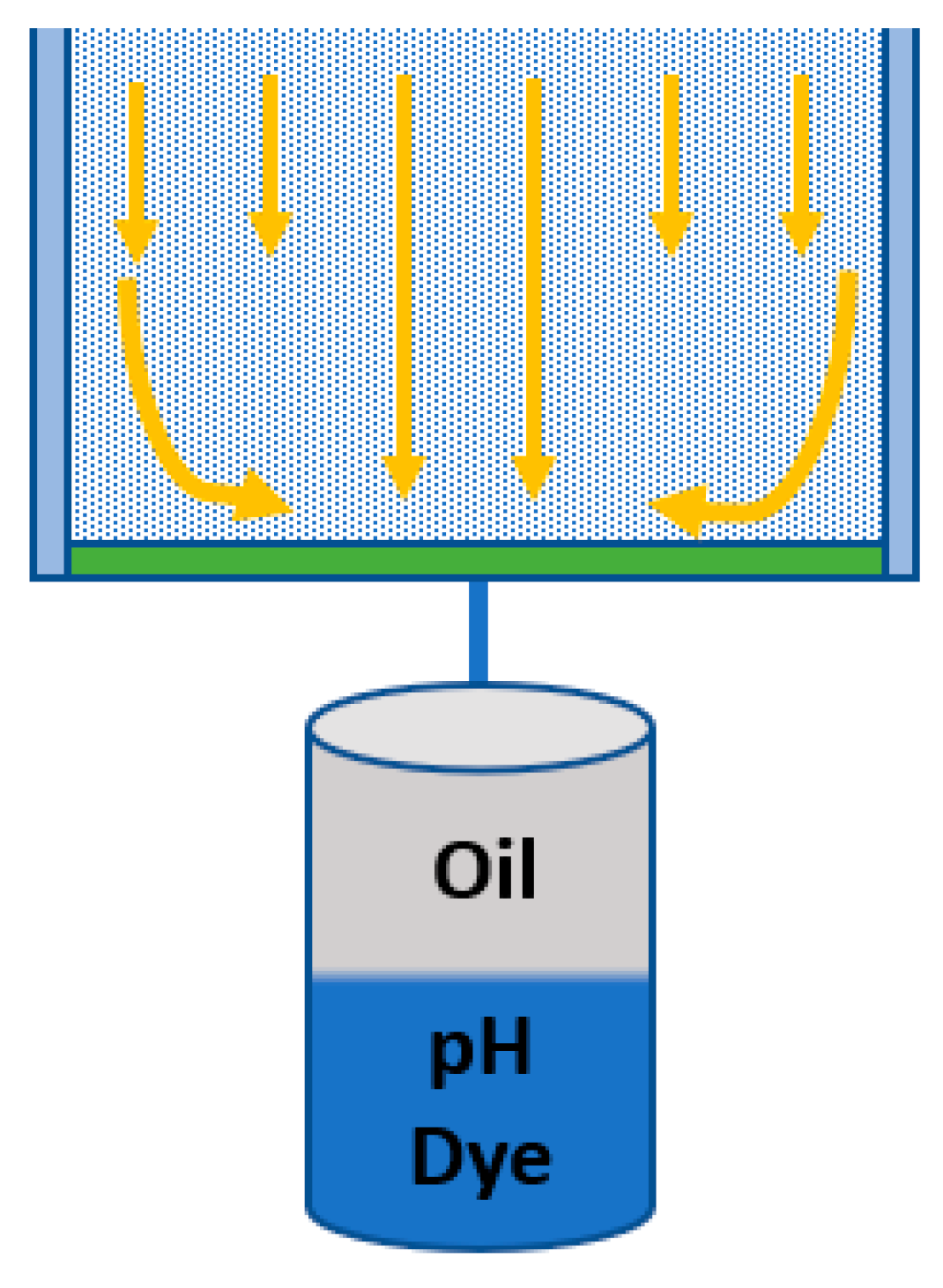
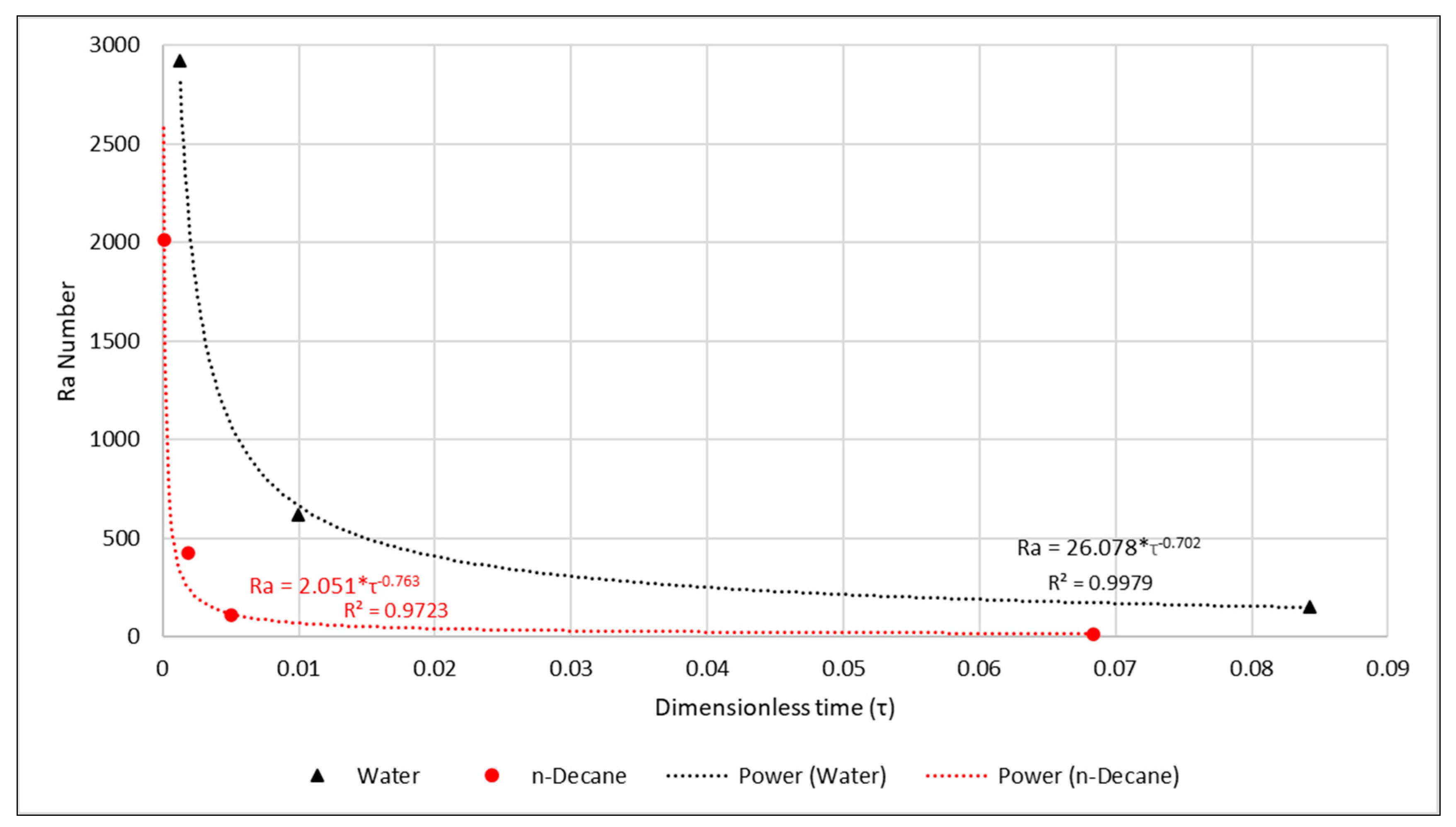
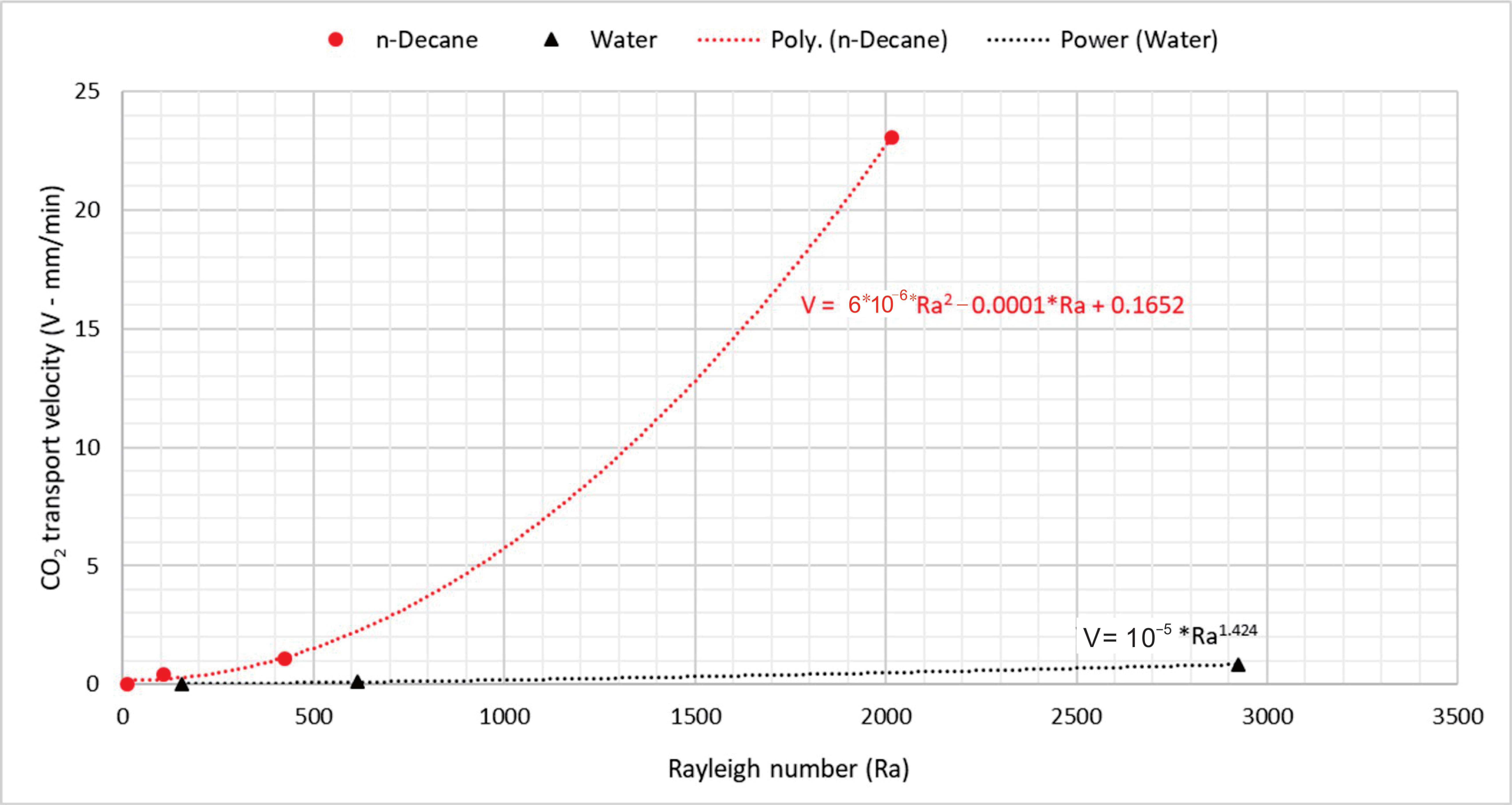
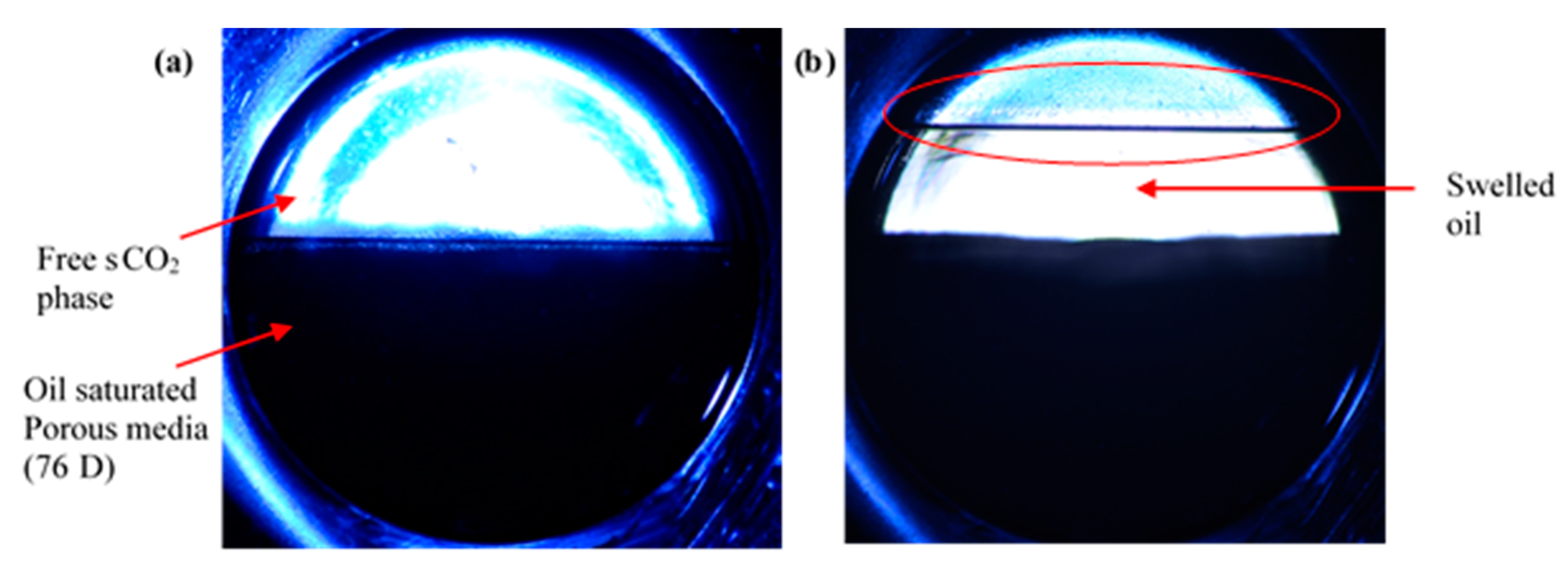
| Component | mol % |
|---|---|
| C5 | 2 |
| C6 | 3 |
| C7 | 5 |
| C8 | 5 |
| C9 | 6 |
| C10 | 4 |
| C11 | 4 |
| C12 | 4 |
| C13 | 4 |
| C14 | 3 |
| C15 | 3 |
| C15+ | 57 |
| Total | 100 |
| Test No. | Glass Beads (µm) | Oil Type | Estimated Permeability (D) * | Rayleigh Number (Ra) | Average Breakthrough Time | Average CO2 Transport Speed (V—mm/min) |
|---|---|---|---|---|---|---|
| 1 | 400–600 | n-decane | 76 | 2015 | 8 min | 23.08 |
| 2 | 100–200 | n-decane | 16 | 424 | 2.75 h | 1.09 |
| 3 (2 repeats) | 70–110 | n-decane | 4 | 106 | 7.5 h | 0.11 |
| 4 | 0–50 | n-decane | 0.5 | 13 | 102.5 h | 0.03 |
| 5 | 70–110 | crude oil | 4 | not calculated | 29 h | 0.1 |
Publisher’s Note: MDPI stays neutral with regard to jurisdictional claims in published maps and institutional affiliations. |
© 2021 by the authors. Licensee MDPI, Basel, Switzerland. This article is an open access article distributed under the terms and conditions of the Creative Commons Attribution (CC BY) license (http://creativecommons.org/licenses/by/4.0/).
Share and Cite
Amarasinghe, W.; Fjelde, I.; Giske, N.; Guo, Y. CO2 Convective Dissolution in Oil-Saturated Unconsolidated Porous Media at Reservoir Conditions. Energies 2021, 14, 233. https://doi.org/10.3390/en14010233
Amarasinghe W, Fjelde I, Giske N, Guo Y. CO2 Convective Dissolution in Oil-Saturated Unconsolidated Porous Media at Reservoir Conditions. Energies. 2021; 14(1):233. https://doi.org/10.3390/en14010233
Chicago/Turabian StyleAmarasinghe, Widuramina, Ingebret Fjelde, Nils Giske, and Ying Guo. 2021. "CO2 Convective Dissolution in Oil-Saturated Unconsolidated Porous Media at Reservoir Conditions" Energies 14, no. 1: 233. https://doi.org/10.3390/en14010233
APA StyleAmarasinghe, W., Fjelde, I., Giske, N., & Guo, Y. (2021). CO2 Convective Dissolution in Oil-Saturated Unconsolidated Porous Media at Reservoir Conditions. Energies, 14(1), 233. https://doi.org/10.3390/en14010233





